1998 GMC SIERRA warning
[x] Cancel search: warningPage 308 of 452
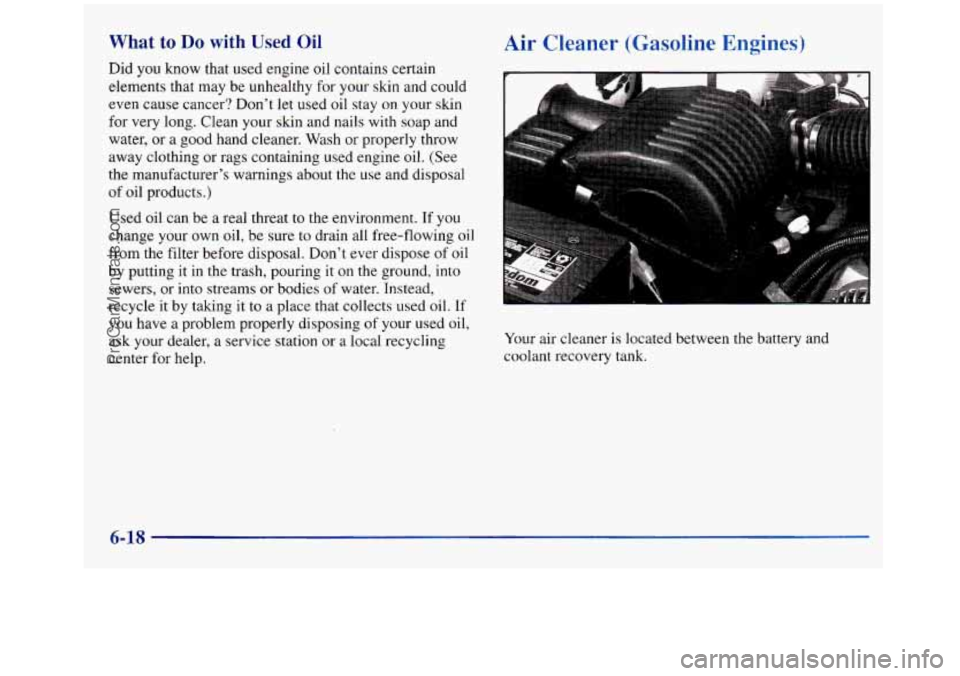
What to Do with Used Oil
Did you know that used engine oil contains certain
e.lements
that may be unhealthy for your skin and could
even cause cancer? Don’t let used oil stay on your skin
for very long. Clean your skin and nails with soap and
water, or a good hand cleaner. Wash or properly throw
away clothing or rags containing used engine oil. (See
the manufacturer’s warnings about
the use and disposal
of oil products.)
Used oil can be a real threat
to the environment. If you
change your own
oil, be sure to drain all free-flowing oil
from the filter before disposal. Don’t ever dispose of oil
by putting
it in the trash, pouring it on the ground, into
sewers, or into streams
or bodies of water. Instead,
recycle it by taking it to a place that collects used oil.
If
you have a problem properly disposing of your used oil,
ask your dealer, a service station or a local recycling
center for help.
Air Cleaner (Gasoline Engines)
Your air cleaner is located between the battery and
coolant recovery tank.
6-18
ProCarManuals.com
Page 318 of 452

How to Check Lubricant
If the level is below the bottom of the filler plug hole,
you may need to add some lubricant.
When the differential is cold, add enough lubricant to
raise the level to 1/2 inch (12
mrn) below the filler
plug hole.
When the differential is at operating temperature
(warm), add enough lubricant to raise the level to the
bottom
of the filler plug hole.
What to Use
Refer to the Maintenance Schedule to determine what
kind of lubricant to use. See “Recommended Fluids and
Lubricants” in the Index.
Engine Coolant
The cooling s stem in your vehicle is filled with
DEX-COOL engine coolant. This coolant is designed
~
to remain in your vehicle for 5 years or 150,000 miles I
(240 000 km) whichever occurs first, if you add only ~
DEX-COOL’ extended life coolant.
8
The following explains your cooling system and how
to add coolant when it is low. If you have a problem
i
with engine overheating, see “Engine Overheating” in 1
the Index.
A 50/50 mixture of water and DEX-COOL@ coolant will: 1
0 Give freezing protection down to -34°F (-37°C).
0 Give boiling protection up to 265 OF (1 29 O C).
Protect against rust and corrosion.
0 Help keep the proper engine temperature.
0 Let the warning gages work as they should.
6-28 ;L
ProCarManuals.com
Page 319 of 452
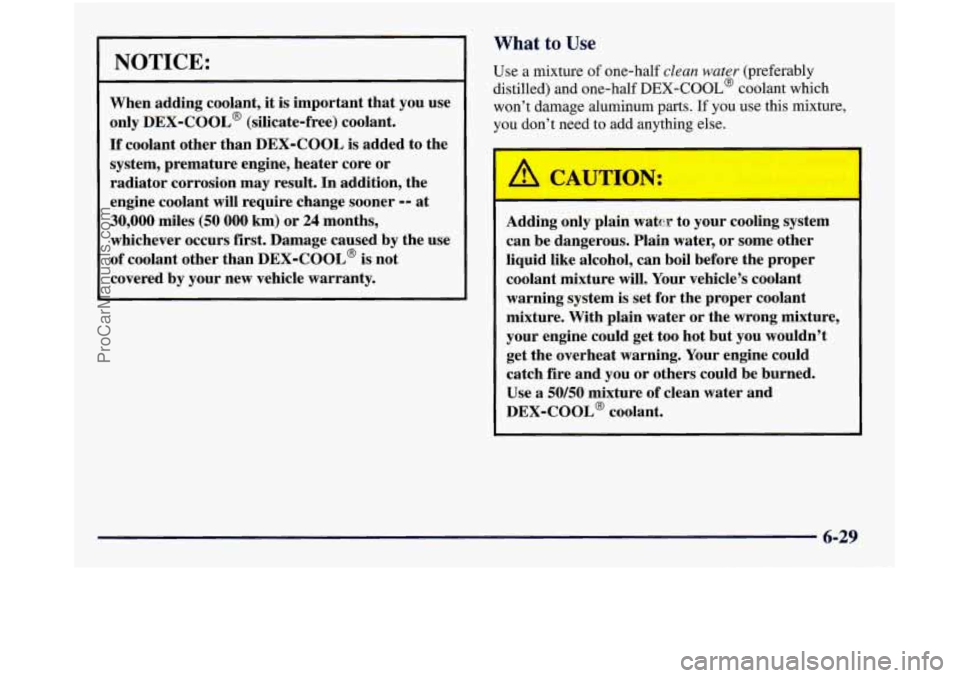
NOTICE:
When adding coolant, it is important that you use
only
DEX-COOL@ (silicate-free) coolant.
If coolant other than DEX-COOL is added to the
system, premature engine, heater core or
radiator corrosion may result. In addition, the
engine coolant will require change sooner
-- at
30,000 miles (50 000 km) or 24 months,
whichever occurs first. Damage caused by the use
of coolant other than DEX-COOL@ is not
covered by your new vehicle warranty.
What to Use
Use a mixture of one-half clean water (preferably
distilled) and one-half
DEX-COOL@ coolant which
won’t damage aluminum
parts. If you use this mixture,
you don’t need to add anything else.
CAUTION:
Adding only plain water to your cooling system
can be dangerous. Plain water, or some other
liquid like alcohol, can boil before the proper
coolant mixture will. Your vehicle’s coolant
warning system is set for the proper coolant
mixture. With plain water or the wrong mixture,
your engine could get too hot but you wouldn’t
get the overheat warning. Your engine could
catch fire and you or others could be burned.
Use a
50/50 mixture of clean water and
DEX-COOL@ coolant.
6-29
ProCarManuals.com
Page 327 of 452
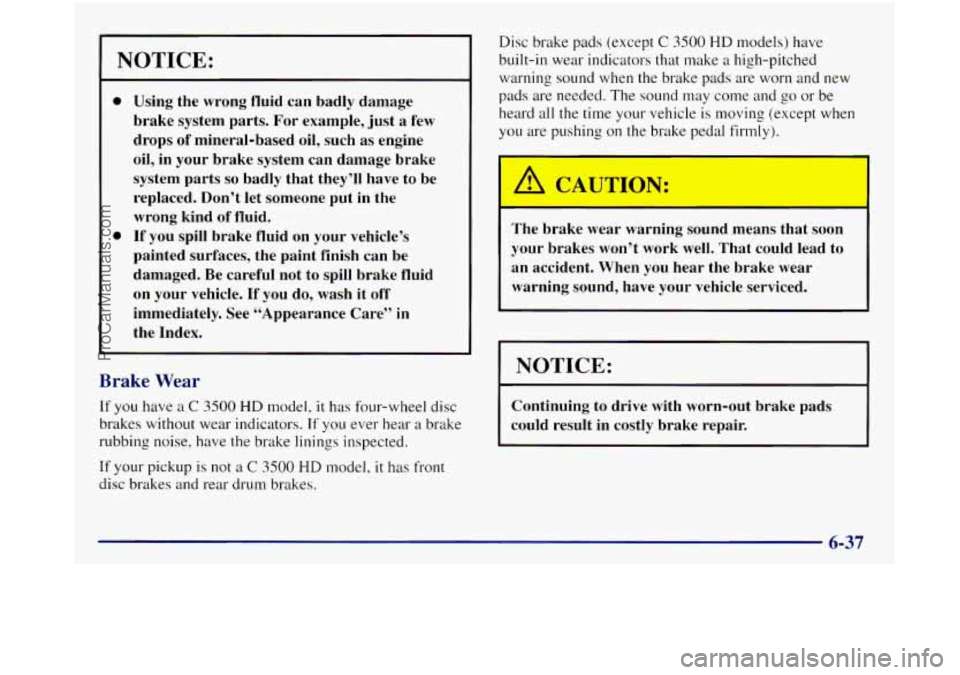
NOTICE:
0
0
Using the wrong fluid can badly damage
brake system parts. For example, just a few
drops of mineral-based oil, such as engine
oil, in your brake system can damage brake
system parts
so badly that they’ll have to be
replaced. Don’t let someone put in the
wrong kind of fluid.
If you spill brake fluid on your vehicle’s
painted surfaces, the paint finish can be
damaged.
Be careful not to spill brake fluid
on your vehicle. If you do, wash it
off
immediately. See “Appearance Care” in
the Index.
Brake Wear
If you have a C 3500 HD model, it has four-wheel disc
brakes without wear indicators. If you ever hear
a brake
rubbing noise, have the brake linings inspected.
If your pickup is not a
C 3500 HD model, it has front
disc brakes and rear drum brakes. Disc brake pads
(except
C 3500 HD models) have
built-in wear indicators that make a high-pitched
warning sound when the brake pads are worn and new
pads
are needed. The sound may come and go or be
heard
all the time your vehicle is moving (except when
you are pushing
on the brake pedal firmly).
I
The brake wear warning sound means that soon
your brakes won’t work well. That could lead to
an accident. When you hear the brake wear
warning sound, have your vehicle serviced.
I NOTICE:
Continuing to drive with worn-out brake pads
could result in costly brake repair.
6-37
ProCarManuals.com
Page 348 of 452
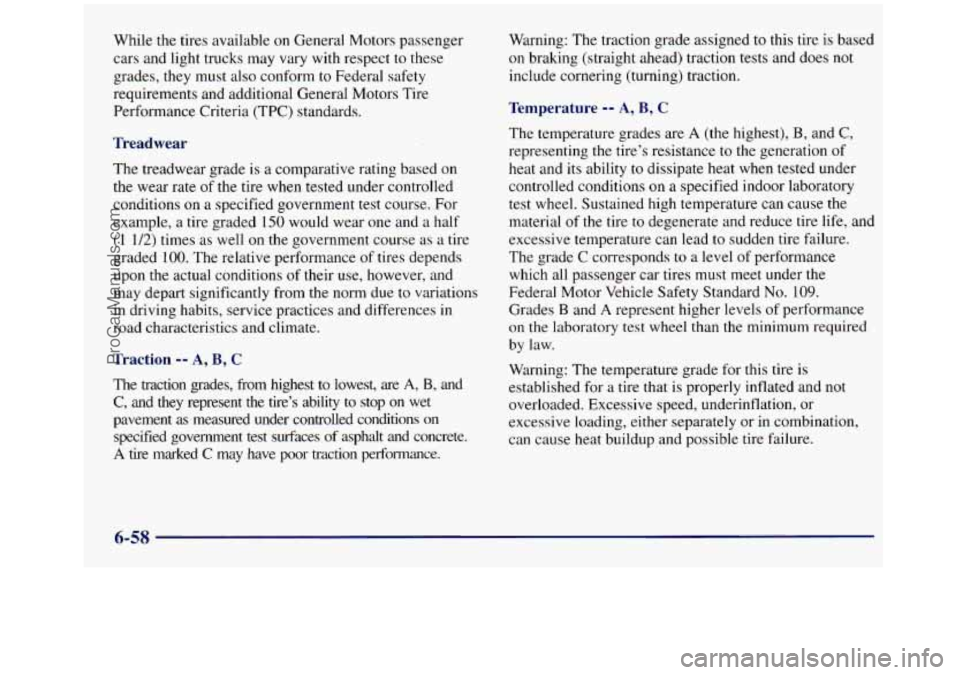
While the tires available on General Motors passenger
cars and light trucks may vary with respect to these
grades, they must also conform to Federal safety
requirements and additional General Motors Tire
Performance Criteria (TPC) standards.
Treadwear
The treadwear grade is a comparative rating based on
the wear rate of the tire when tested under controlled
conditions on a specified government test course. For
example, a tire graded 150 would wear one and a half
(1 1/2) times as well on the government course as a tire
graded
100. The relative performance of tires depends
upon the actual conditions of their use, however, and
may depart significantly from the norm due to variations
in driving habits, service practices and differences in
road characteristics and climate.
Traction -- A, B, C
The traction grades, from highest to lowest, are A, B, and
C, and they represent the tire’s ability to stop
on wet
pavement
as measured under controlled conditions on
specified government test surfaces of asphalt and concrete.
A tire marked C may have poor traction performance. Warning:
The traction grade assigned to this tire is based
on braking (straight ahead) traction tests and does not
include cornering (turning) traction.
Temperature -- A, B, C
The temperature grades are A (the highest), B, and C,
representing the tire’s resistance to the generation of
heat and its ability
to dissipate heat when tested under
controlled conditions
on a specified indoor laboratory
test wheel. Sustained high temperature can cause the
material of
the tire to degenerate and reduce tire life, and
excessive temperature can lead to sudden tire failure.
The grade
C corresponds to a level of performance
which
all passenger car tires must meet under the
Federal Motor Vehicle Safety Standard
No. 109.
Grades B and A represent higher levels of performance
on the laboratory test wheel than the minimum required
by law.
Warning: The temperature grade for this tire is
established for a tire that is properly inflated and
not
overloaded. Excessive speed, underinflation, or
excessive loading, either separately or in combination,
can cause heat buildup and possible tire failure.
6-58
ProCarManuals.com
Page 351 of 452
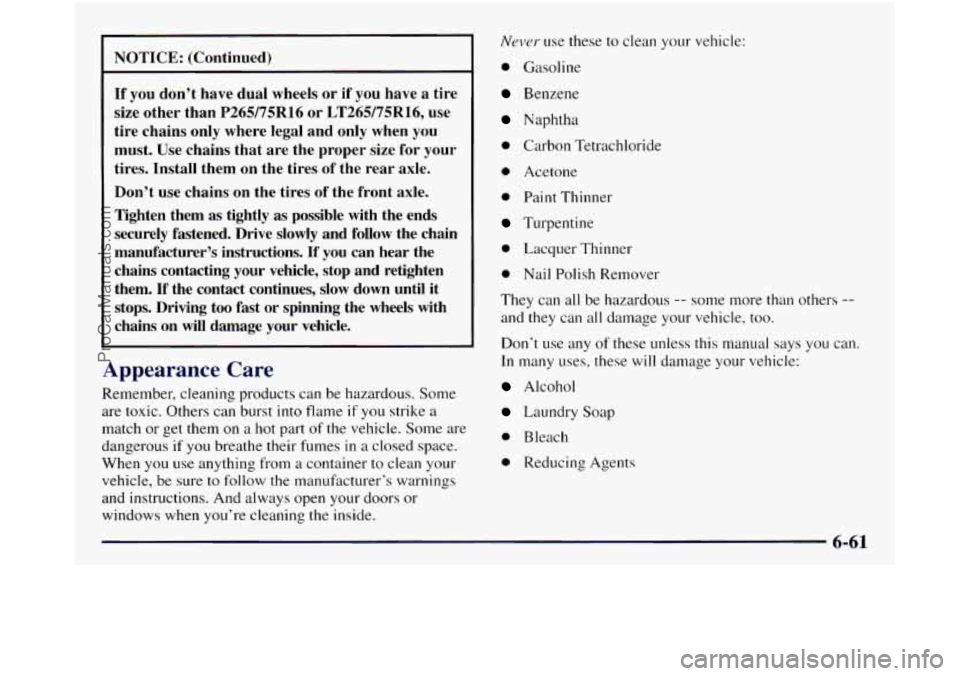
NOTICE: (Continued) -
If you don’t have dual wheels or if you have a tire
size other than
P265/75R16 or LT265/75R16, use
tire chains only where legal and only when you
must. Use chains that are the proper size for your
tires. Install them on the tires of the rear axle.
Don’t use chains on the tires of the front axle.
Tighten them
as tightly as possible with the ends
securely fastened. Drive slowly and follow the chain
manufacturer’s instructions. If you can hear the
chains contacting your vehicle, stop and retighten
them.
If the contact continues, slow down until it
stops. Driving too fast or spinning the wheels with
chains on will damage your vehicle.
Appearance Care
Remember, cleaning products can be hazardous. Some
are toxic. Others can burst into flame
if you strike a
match or get them on
a hot part of the vehicle. Some are
dangerous if
you breathe their fumes in a closed space.
When you use anything from
a container to clean your
vehicle, be sure
to follow the manufacturer’s warnings
and instructions. And always open your doors or
windows when you’re cleaning the inside.
NevcJr use these to clean your vehicle:
0 Gasoline
Benzene
Naphtha
0 Carbon Tetrachloride
0 Acetone
0 Paint Thinner
Turpentine
0 Lacquer Thinner
0 Nail Polish Remover
They can
all be hazardous -- some more th .an others --
and they can all damage your vehicle, too.
Don’t use any
of these unless this manual says you can.
In many uses, these will damage your vehicle:
Alcohol
Laundry Soap
0 Bleach
0 Reducing Agents
6-61
ProCarManuals.com
Page 364 of 452

Fuse/Circuit Breaker Usage
20
21
22
23
24
A
B
PRNDL, Automatic Transmission,
Speedometer, Check Gages
Warning Light
Security/Steering
Not Used
Not Used
Front Axle,
4WD Indicator Lamp,
TP2 Relay (Gasoline Engine)
Power Door Lock, Six-Way Power Seat, Keyless Entry Module
Power Windows
Underhood Fuse/Relay Center
The underhood fusehelay center is located in the rear of
the engine compartment near the brake fluid reservoir.
Move the retainer clips
for the cover to access the
fuse block.
You can remove fuses with a fuse extractor. The fuse
extractor
is mounted to the interior fuse block. TO
remove fuses
if you don’t have a fuse extractor, hold the
end of the fuse between your thumb and index finger
and pull straight out.
6-74
ProCarManuals.com
Page 435 of 452

Section 9 Index
Accessory Power Outlet ......................... 2-59
AirBag ....................................... 1-23
Adding Equipment
............................ 1-3 1
How Does it Restrain .......................... 1-28
How it Works ................................ 1 -26
Location .................................... 1-26
Readiness Light ......................... 1.25, 2.65
What Makes it Inflate .......................... 1-27
What Will You See After
it Inflates ............... 1-28
When Should it Inflate ......................... 1-27
Air Bag
Off Light .......................... 1.58. 2.65
Air Cleaner
.................................... 6- 18
Air Cleaner Filter Restriction Indicator Check ........ 7-41
Air Conditioning ............................ 3.3. 3.4
Air Conditionillg Refrigerants ..................... 6-79
Alignment and Balance. Tire
...................... 6-59
Antenna
...................................... 3-26
Antifreeze
........................... 6-28.6-79.7-46
Anti-Lock Brake System Warning Light
................ 2.68. 4.7
Brakes ...................................... 4-7
Appearance Care
............................... 6-6 I
Adding Equipment to the Outside of Your Vehicle ...... 6-3
Servicing
................................... 1-30
Aluminum Wheels. Cleaning ...................... 6-67
Appearance Care and Materials .................... 6-69
Arbitration Program .............................. 8-9
Armrest Storage Compartment
.................... 2-56
Audio Equipment. Adding
........................ 3-24
Audio System
.................................. 3-7
Automatic Transmission
Check
...................................... 7-41
Fluid
.................................. 6-21. 7-47
Operation ................................... 2-15
Park Mechanism Check
........................ 7-43
Starting Your Engine
.......................... 2-12
Axle. Front
............................... 6-27. 7-47
Axle. Locking Rear
............................. 2-32
Axle. Rear
............................... 6-26. 7-47
Ashtrays ...................................... 2-58
Battery
...................................... 6-39
Jump Starting
................................. 5-3
Warnings ................................ 5-3. 5-5
BBB Auto Line ................................. 8-9
Better Business Bureau Mediation ................... 8-9
Blizzard. Driving
In ............................. 4-38
Replacement.
Keyless Entry ..................... 2-8
9-1
ProCarManuals.com